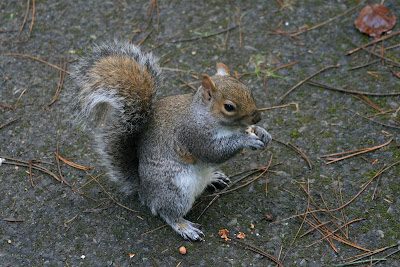In 1795 the Royal Dublin Society aided by state funding purchased lands at Glasnevin for the purpose of building a National Botanical Gardens, which were first opened to the public in 1800. The first of the magnificent curvilinear glass houses, built by Dublin iron master Richard Turner, was opened in 1849 to coincide with a visit by Queen Victoria. The gardens are set in almost 20 hectares and feature more than 15,000 living plants including specimens from alpine, sub tropical and tropical climes. The gardens also contain more than 300 endangered plant species and another 6 species which are already extinct in the wild. As well as acting as a living reference library for gardeners, hortaculturists and botanists, the gardens are a wonderful public amenity and haven for wildlife, and I am very fortunate to live literally two minutes around the corner from the front gates!
 |
"Turner's Masterpieces"
Looking West past the magnificent glasshouses. constructed by
Dubliner Richard Turner |
 |
"Flower Power"
When in bloom the flower gardens draw crowds from near and far, by the coach load . |
 |
"Sun Dappled Pathway"
The gardens are a favourite place for walking and many northside
Dubliners exercise there daily. |
 |
Grey Squirrel (Neosciurus corolinensis)
Introduced to Britain and Ireland from the Americas and its rapid spread
has coincided with the demise of our native Red Squirrel (Sclurus vulgaris).
It must be twenty years since I last saw a red squirrel in the Gardens,
but today the greys are everywhere! |
 |
Great Cormorant (Phalacrocorax carbo)
Occasionally seen fishing in the River Tolka which forms the northern perimeter of the
Gardens. This particular bird has just swallowed a trout of about 2lbs (.91kgs)! |
 |
Bullfinch (Pyrrhula pyrrhula)
Several pairs breed in the Gardens, and despite the bright colours of the male they can be remarkably
difficult to observe. The female is very drab and in many cases all one sees is a pair of white rumps
as they fly quickly and quietly away. |
 |
Wood Duck (Aix sponsa)
This was the first wood duck I had ever seen in Ireland. A female, it was observed on numerous occasions over a two year period, on or near the pond in the centre of the gardens, where it seemed more than happy to mix with the local mallard population. |
 |
Brown Rat (Rattus norvegicus)
Brown rats are excellent swimmers and are very common throughout Europe. I watched this one
swim across the Tolka River before it scrambled up the bank and disappeared into the undergrowth.
|

















++.jpg)


No comments:
Post a Comment